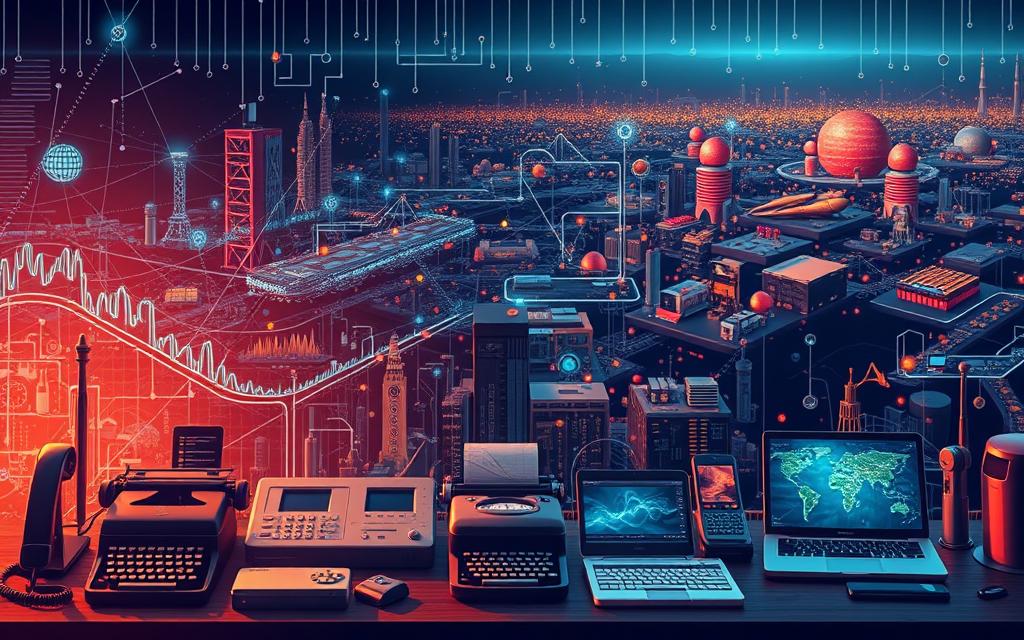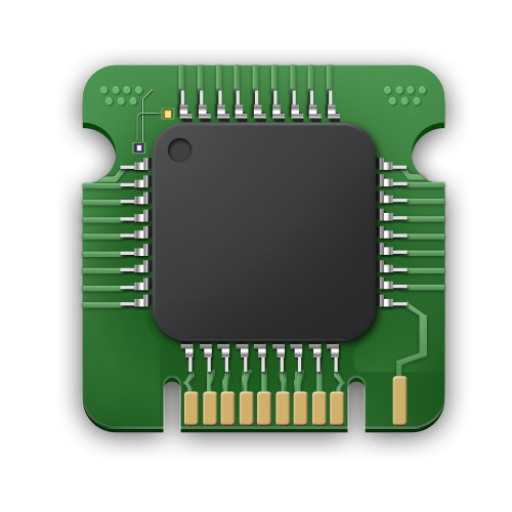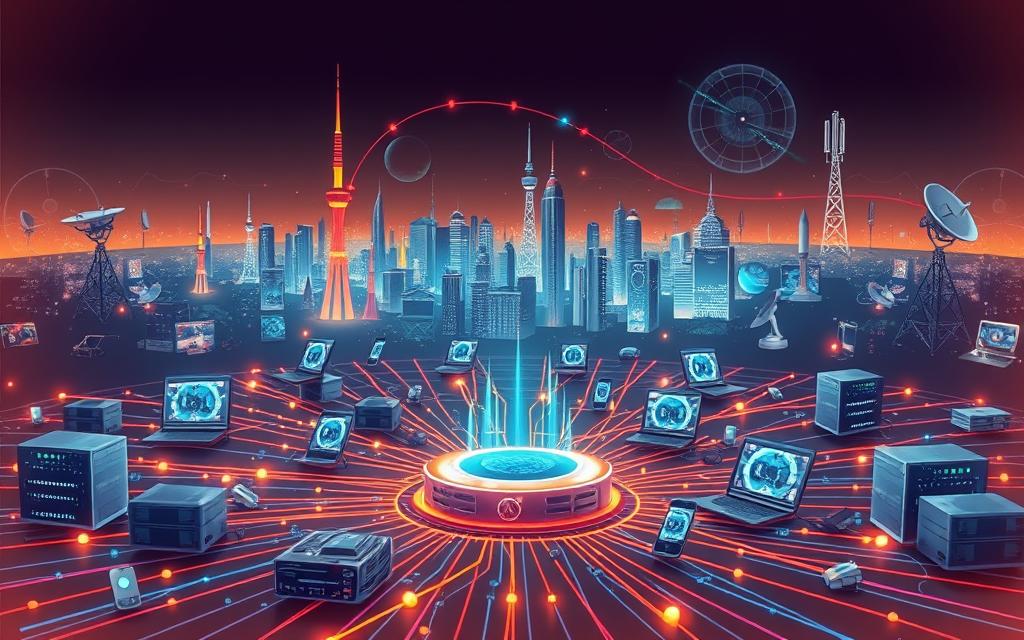In today’s digital age, information technology and communication play a vital role in shaping our world. As an extensional term for information technology, ICT emphasizes unified communications and the integration of telecommunications and computers.
This comprehensive guide will explore the fundamental concepts, evolution, and significance of ICT in various sectors, including business, education, healthcare, and government. By understanding the core components of ICT systems, including hardware, software, and network infrastructure, we can better navigate the increasingly digital world.
As we examine the transformative impact of information and communication technology, it becomes clear that ICT serves as an umbrella term encompassing various technologies that store, retrieve, manipulate, transmit, or receive data electronically in digital form.
What is Information Technology and Communication?
ICT, or Information and Communication Technology, is a comprehensive discipline that includes hardware, software, and services used for information processing and communication. It represents the convergence of telecommunications, computing, and media technologies that facilitate information exchange.
Definition and Scope of ICT
The scope of ICT extends beyond traditional computing to encompass all technologies that enable users to create, access, store, transmit, and manipulate information in various formats. This includes both analog technologies, like paper communication, and digital technologies, such as smartphones and computers.
Difference Between IT, IS, and ICT
Information Technology (IT) primarily focuses on computer-based information systems, whereas ICT incorporates broader communication aspects, including telecommunications. Information Systems (IS) refers to the interaction between people, processes, data, and technology, while ICT emphasizes the technological infrastructure that enables communication. Understanding these distinctions is crucial for professionals in technology-related fields.
The Evolution of Information and Communication Technology
The evolution of information and communication technology has been a gradual process, spanning several decades. This journey has transformed the way we live, work, and interact with one another.

Historical Development of ICT
The historical development of ICT began with early networking concepts in the 1960s. J. C. R. Licklider’s ideas on networking laid the groundwork for modern ICT systems. The 1969 development of ARPANET, the first operational packet-switching network, marked a significant milestone. It was the precursor to the modern internet and played a crucial role in the development of communication technologies.
Key Milestones in ICT History
Several key milestones have defined the history of ICT. The standardization of the TCP/IP protocol suite in 1982 enabled the global interconnection of diverse computer networks. The invention of the World Wide Web in 1989 by Tim Berners-Lee revolutionized information sharing and accessibility. The release of the Mosaic web browser in 1993 further transformed how people interact with digital content. More recent developments include the emergence of mobile technologies, cloud computing, big data analytics, and the Internet of Things (IoT), all of which continue to expand the capabilities and applications of ICT in society.
Core Components of ICT Systems
Understanding ICT systems requires examining their fundamental components. These components work together to enable the efficient processing, storage, and communication of information.
Hardware Elements
Hardware forms the physical foundation of ICT systems, including devices like computers, servers, smartphones, and networking equipment. The exponential growth in hardware capabilities has enabled the storage and processing of vast amounts of data. By 2014, global storage capacity had reached 5 zettabytes.
Software and Applications
Software components provide the instructions and logic that enable hardware to perform specific tasks, ranging from operating systems to specialized industry solutions. Applications represent user-facing software designed to fulfill specific functions, with modern app ecosystems offering solutions for virtually every personal and professional need.
Networks and Communication Infrastructure
Networks and communication infrastructure serve as the connective tissue of ICT systems, including local area networks (LANs), wide area networks (WANs), and the global internet. The integration of these core components creates comprehensive ICT ecosystems that power modern digital services.
The Importance of ICT in Modern Society
The information communication technology (ICT) industry has emerged as a pivotal force in modern society, driving economic growth and social transformation. As a significant sector, its influence extends beyond the economy into various aspects of daily life and global development.
Economic Impact and Market Size
The ICT industry is one of the world’s largest, with a market size approaching $6 trillion. This substantial economic footprint underscores its critical role in global development. ICT drives productivity and efficiency across virtually all industries, enabling innovation, automation, and the optimization of business processes. The United Nations recognizes ICT as instrumental in achieving the 17 Sustainable Development Goals, highlighting its potential to address global challenges.
Social and Cultural Transformation
Digital technologies have fundamentally transformed social interactions and cultural expression, creating new forms of community, entertainment, and artistic production. ICT has democratized access to information and knowledge, empowering individuals and communities with resources previously available only to privileged groups. The pervasive nature of ICT in modern society has created both opportunities and responsibilities, requiring thoughtful approaches to digital inclusion, privacy, and ethical technology use.
- The ICT industry is a major economic sector, nearing a $6 trillion market size.
- ICT drives innovation and efficiency across industries.
- Digital technologies have transformed social interactions and cultural expression.

ICT Applications Across Different Sectors
The versatility of ICT is evident in its widespread adoption across different industries, including business, education, healthcare, and government services. ICT has become a cornerstone in enhancing operational efficiency and service delivery across these sectors.
Business and Industry
In business, ICT enables enterprise resource planning, customer relationship management, and supply chain optimization, thereby enhancing competitiveness and operational efficiency. Digital transformation initiatives are reshaping traditional business models, creating new value propositions and revenue streams through technologies like cloud computing and big data analytics.
Education and Learning
Education has been revolutionized by ICT through e-learning platforms and digital classrooms, personalizing learning experiences and extending educational access to underserved populations. M-Learning has proven particularly valuable in developing regions, allowing educators to reach students in remote areas and track progress more effectively.

Healthcare and Medicine
In healthcare, ICT applications include electronic health records, telemedicine, and health informatics, improving diagnostic accuracy and treatment outcomes.
Government and Public Services
Government and public services leverage ICT for e-governance initiatives and digital citizen services, enhancing transparency and efficiency. For more on the fundamentals of ICT, visit techhack.co.uk.
Challenges and Ethical Considerations in ICT
Despite the advancements in ICT, the world is faced with pressing issues such as the digital divide, data privacy concerns, and environmental impact. The increasing reliance on information and communication technologies has brought to the forefront several challenges that need to be addressed to ensure equitable and sustainable development.
The Digital Divide
The digital divide represents a significant challenge in ICT, with stark disparities in technology access between developed and developing regions. According to the International Telecommunication Union, while Europe and the Americas have 80-90% internet penetration, Africa remains at only 40%, highlighting the uneven distribution of digital resources.
Data Privacy and Security Concerns
Data privacy and security concerns have intensified as organizations collect and process unprecedented volumes of personal data, raising questions about consent, ownership, and appropriate use of sensitive information. Cybersecurity threats continue to evolve in sophistication, with ransomware attacks, data breaches, and identity theft posing significant risks to individuals, businesses, and critical infrastructure.
Environmental Impact of Technology
The environmental impact of technology includes electronic waste, energy consumption of data centers, and the carbon footprint of device manufacturing. Addressing these challenges requires collaborative efforts between governments, industry, and civil society to develop ethical frameworks and policies that maximize benefits while minimizing harms.
| Challenge | Description | Impact |
|---|---|---|
| Digital Divide | Disparities in technology access | Inequality and exclusion |
| Data Privacy and Security | Collection and processing of personal data | Risks to individuals and businesses |
| Environmental Impact | Electronic waste and energy consumption | Environmental degradation |

Emerging Trends in Information and Communication Technology

The landscape of Information and Communication Technology (ICT) is rapidly evolving, driven by innovations that are transforming how we live and work. Several key trends are emerging, shaping the future of ICT.
Artificial Intelligence and Machine Learning
Artificial intelligence (AI) and machine learning are revolutionizing ICT by enabling systems that can learn from data, recognize patterns, and make decisions with minimal human intervention. Applications like natural language processing and predictive analytics are enhancing user experiences.
Cloud Computing and Edge Technologies
Cloud computing continues to evolve, offering specialized services like machine learning platforms and serverless computing. Cloud services are being complemented by edge computing, which processes data closer to its source, reducing latency.
Internet of Things (IoT)
The IoT ecosystem is expanding rapidly, with projections indicating 29 billion connected devices by 2030. This growth is creating new opportunities for data collection and automated decision-making, but also raises concerns about cybersecurity.
5G and Advanced Networking
5G networks represent a significant advancement in wireless communication, offering increased bandwidth and reduced latency. This will enable new applications in areas like autonomous vehicles and smart cities, further transforming the ICT landscape. For more information on the different types of information technology, visit TechHack.
Conclusion
Ultimately, the field of information technology and communication continues to shape our future. As ICT evolves, it transforms how we work, learn, and interact across various domains. Staying informed about emerging technologies and developing relevant skills is crucial for personal and professional growth.
The field offers diverse opportunities for ICT professionals, ranging from technical specializations to roles that bridge technology and business strategy. Organizations leveraging information communication technology effectively gain competitive advantages through enhanced efficiency, innovation, and customer engagement. For more insights on the impact of technology, visit this article on how technology affects people.
As we look to the future, developing digital literacy and specialized ICT skills will open doors to new opportunities and enable participation in the digital economy, regardless of one’s specific interests or career path. Understanding these technologies is an essential component of modern education and professional development.







